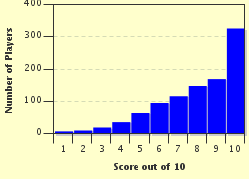Quiz Answer Key and Fun Facts
1. As is the case in many Asian countries, the Lunar New Year is celebrated with great enthusiasm in Thailand. But the Thai people celebrate it at a different time from most countries, on a date shortly after the vernal (spring) equinox. What are the traditional dates of the Songkran Festival in Thailand?
2. During the second half of the twentieth century, May 3 marked the start of a three-day celebration for the Thai people. The first day included a Buddhist ceremony; the second day's ceremony had a Brahmanic part and a Buddhist one; on the third day the king threw a feast for the Buddhist monks, among other activities. What holiday was being celebrated on May 5 in Thailand?
3. The majority of the Thai populace are farmers, and agricultural festivals play an important part in their lives. Which ceremony, in which sacred bulls play a significant role, can you observe during May if you visit Sanam Luang, the open field in front of the Grand Palace in Bangkok?
4. 'Boon Luang' is a three-day festival celebrated annually during the summertime in the northeastern Thai town of Dan Sai. It starts off with 'Phi Ta Khon', a parade of celebrants dressed as ghosts and monsters, wearing colourful masks. What is the English translation of 'Phi Ta Khon'?
5. The festival of Kathina is celebrated at the end of Vassa, or the Rains Retreat, which is a three-month period, usually lasting from July to October, in which monks of Thailand's predominant religion stay inside their monasteries and engage in prolonged meditation. What is the religion which these 'bhikkus' practice?
6. In August, the small town of Chonburi is the site for a uniquely Thai event that developed from a social gathering of local farmers who decided to hold a competition when they gathered for trade. What animals raced around the fields of Chonburi for the 139th time in 2010?
7. The people of Thailand freely celebrate Chulalongkorn Day on October 23, the anniversary of the death of King Chulalongkorn, also known as Rama V. For which of these liberating actions is he best remembered?
8. 'Loy Krathong', celebrated on the night of the full moon in November, can be translated as 'floating leaf-cup'. Traditionally a cup is shaped from banana wood decorated with banana leaves, and has items placed in it before being sent on its journey down the river. Which of these is *NOT* one of the items traditionally placed in a krathong?
9. Every year, the Thai people celebrate the birthday of their reigning monarch. Throughout the second half of the twentieth century, and the first decade of the twenty-first, this was His Majesty King Bhumibol Adulyadej the Great, whose birthday was 5 December. This creative monarch was the first member of Thai royalty to do which of the following?
10. Having never been part of a European colonial empire, Thailand does not have an Independence Day. However, on December 10 they do celebrate 'Constitution Day', in recognition of the transition from an absolute monarchy to a constitutional monarchy with a legislature called the People's Assembly. In what year did this occur?
Source: Author
looney_tunes
This quiz was reviewed by FunTrivia editor
stedman before going online.
Any errors found in FunTrivia content are routinely corrected through our feedback system.

